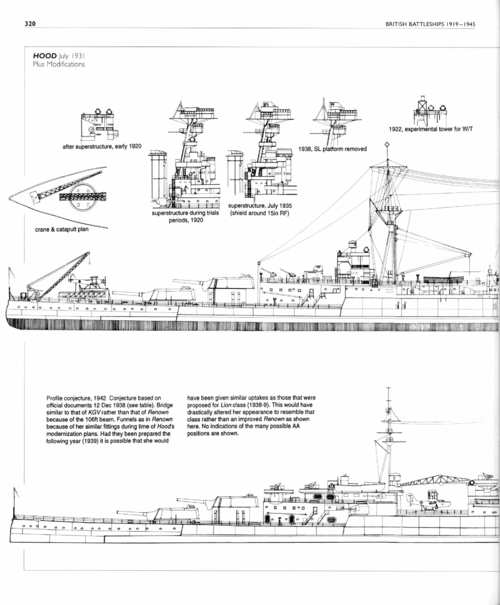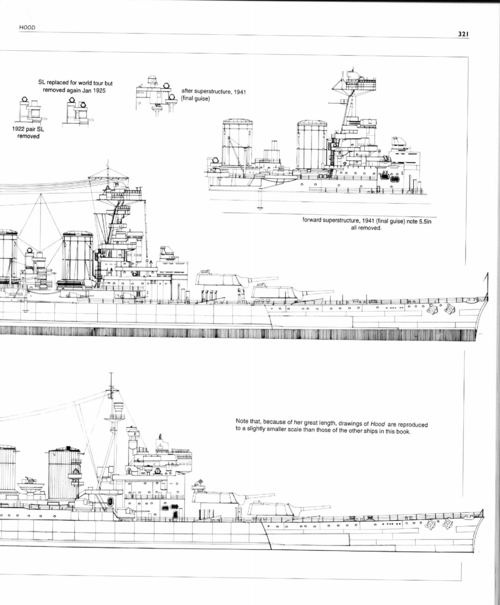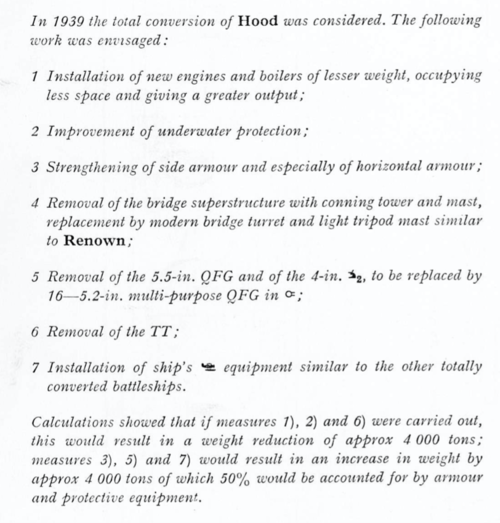I you look at all the major--and minor-- refits the RN did to battleships between the wars you'll find the results were very much hit and miss. In some cases like, Royal Oak, Renown, or Queen Elizabeth these were substantial and improved the ships considerably. In others, they were marginal doing little to really increase fighting power. This is largely because the British government really didn't have the money between the wars to make across the board major improvements to their existing ships.
The result is that Hood's big refit would have depended heavily on what could be financed rather than what was really needed. Would it have helped? Definitely. Any upgrades would have been better than none. It would have helped with the machinery situation and ship's operability too. As to what gets done? That depends on how liberally the government is willing to finance the refit.
Hit and miss is a rather harsh view of the BB modernisation programme in the RN. It hides both progression and policy changes along the way.
Burt in British Battleships 1919-1945, breaks things down into 2 phases (which perhaps ought to be 3). Phase 1 begins in the 1920s with the fitting of bulges and improvements to AA armament over WW1. It ends in late 1933/early 1934 with Barham.
The next phase begins in 1933/34 with Repulse, Malaya and Warspite being given what the Admiralty referred to as “large repairs”. Warspite’s large repair became a more extensive reconstruction because when the opened her up they found her machinery was in such a bad state that it needed replaced. As that needed done anyway they took to opportunity to carry out further improvements. That seems to be evidenced by her new machinery being ordered very late in the day compared with subsequent ships. So in some ways you could say Warspite just got lucky at that stage in her life. And her machinery layout was different from that subsequently used in Valiant & QE. But she was in hand too early for some of the other Phase 3 changes like the DP armament.
By that stage it had already been decided that the R class would begin to be scrapped from 1940 with the last going in 1942. So why spend a lot of money on them? Quite why so much should have been spent on Royal Oak I’m not clear about. Perhaps it was simply the fact that she was the first due for the next round of refits to the class and could be expected to be the ship lasting longest into 1942.
Then we have what I see as phase 3. On 12 June 1934 the Admiralty sets up a committee on the “Modernisation of Existing Capital Ships”. While a Warspite fell under its remit as more extensive works were needed than originally planned, Renown, Valiant and QE are the true product of that process with new machinery and a new previously unavailable DP armament being specified. Hood, Nelson and Rodney were all intended to follow and would have but for the outbreak of war.
Money was an issue until the mid-1930s but so was the overall strategic view of the RN in the world. After 1930 it has only 15 capital ships. It was nervous of having more than 3 at a time under long term reconstruction at any one time, especially after the Abyssinian crisis of 1935 when war against Italy in the Med seemed increasingly likely. (In 1934-36 there were 4 in long term refit/reconstruction, Repulse, Warspite, Malaya and Royal Oak. That reduced to 3 for the next round and for the planned but not executed subsequent round).
The RN is often compared unfavourably with the USN in terms of modernisations in the 1920s and 1930s. But there are a couple of major differences.
Firstly the USN had acquired a lot of machinery in the run up to the Washington Treaty of 1922 for capital ships that were cancelled under the Treaty. It had spent that money and the best use of it was to modernise many of its older BB. The RN was not in the same position. The ships the RN lost under Washington had only just been ordered with no progress having been made on construction.
Secondly increasing the elevation of the main armament. The RN ships had turrets with 20 degree elevation except for Hood at 30 degrees. This was more than adequate for the shorter ranges that the RN expected to fight at.
The USN was coming from behind. Except for the Big Five of the Tennessee and Colorado classes at 30 degrees, all their BB were 15 degree ships in 1922 and were already capable of being outranged by both Britain and Japan. So for them doing something at that point was more important. So they leapfrogged the RN and went to 30 degrees as standard.
By 1934 the RN looked at what was happening overseas and at the availability of better director systems and realised gun actions may well take place at ranges beyond that which it had planned to fight at, and realised it needed to play catch up. So that too then became part of the modernisation plan.
As to who spent the most inter war on capital ship modernisation I’ve seen arguments that Britain either spent less, equalled or even outspent the USN. Pure cash doesn’t necessarily tell the whole story when wage rates and working practices were different in each country. Maybe some day someone will produce a complete analysis.




